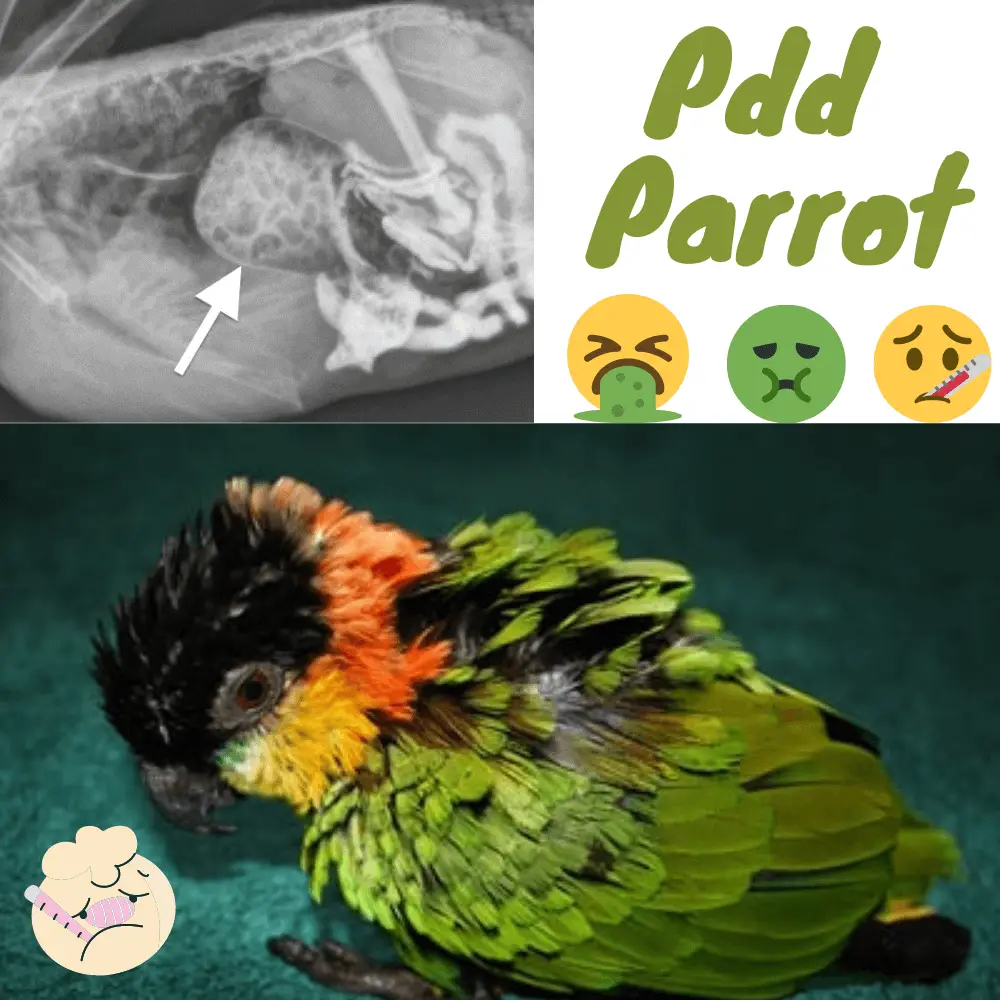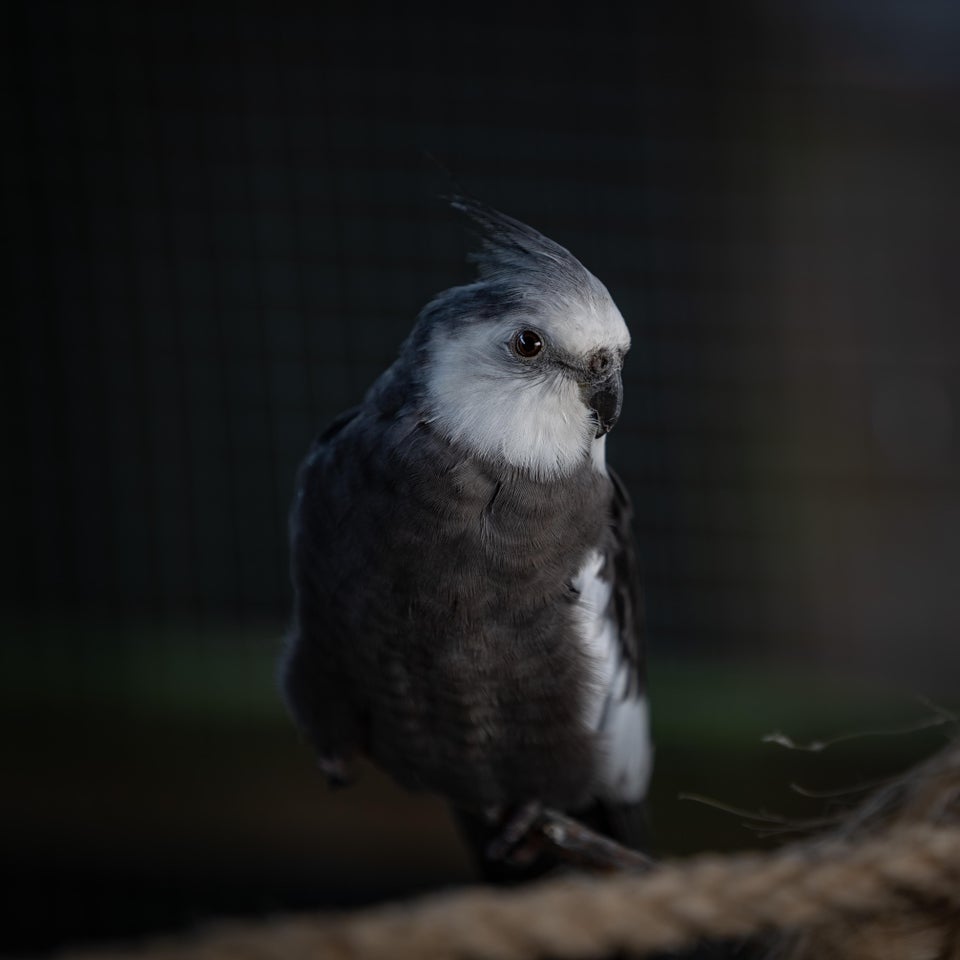
Parrot PDD Symptoms of the disease and The diagnosis: For two years, Eliot the severe macaw has lived peacefully in a large country house. He is the king of the house. He spends hours of fun in the huge toy park set up for him. His diet is complete and varied and he receives a lot of attention from his masters who both work at home. One November morning, when it comes time to say hello to her bird and bring it out of its cage, Anne notices that it is not as usual. His gaze seems glassy and Eliot is not in a hurry to come and hug him. By trying to get him to get on her hand, Anne causes Eliot to fall. He finds himself at the bottom of his cage, wings open. He’s in convulsions.
Eliot is rushed to the hospital. Upon arrival, he is no longer convulsing, but he is unable to stand on his feet and his head is moving in all directions. Examination reveals a lean, dehydrated, and ataxic bird ( incoordination of movements ). A saddle made during handling contains several undigested seeds.
The owner indicates that she had noticed this symptom for some time, but was not worried about it. Eliot was still upbeat and his appetite was excellent. After a series of blood tests and a series of x-rays with contrast medium ( barium), proventricular dilation disease is strongly suspected. The suspicion is confirmed by the result of a microscopic analysis of a section of his crop. The parrot is lucky. He’s getting better.
He is finishing his convalescence at home after a few days of hospitalization. Her medication stopped almost all of the symptoms of the disease. However, it is not possible to determine how long his remission will last. The disease of the dilation of the proventriculus is insidious and progressive.
Green-Winged Macaw Parrot Getting Xrays at the Vet
SOURCE:Parrot Wizard
Description of the disease
Proventriculus dilation disease is caused by a virus. It causes an inflammatory response characterized by the infiltration of blood cells ( lymphocytes and plasma cells ) into the nervous tissues of the body. The most sensitive nerves are those of the proventriculus, the gizzard, the crop, and the small intestine. The disease causes more or less paralysis of the muscles necessary for the contraction and tone of the digestive system. The digestion of food and the absorption of nutrients therefore no longer take place in the normal way. All nerve tissue has the potential to be affected. Symptoms associated with the malfunction of other nerves (paralysis beginning with the legs and progressing in the wings ) or of the brain ( loss of balance, convulsions ) are encountered.
Historical
Symptoms of proventriculus dilation disease were first described in the late 1970s. The problem was seen primarily in macaw parrots imported to the United States and Germany. The health of these birds gradually deteriorated and eventually, they died. Great thinness characterized each of the victims, a secondary sign of poor absorption of their food caused by a malfunction of their digestive system. Very little information was available at the time on this new disease called by scientists “Macaw wasting disease” because it seemed to affect this species in particular. With time, Amazon, cockatoo, conure, toucan, an African gray, Eclectus, cockatiel parakeet, Lori, lovebird, canary, poicephallus, pionus, etc. )
The name “Macaw wasting disease” is then replaced by the term proventricular dilation disease which better describes the disease. It is, therefore, possible to believe that at a time when the disease was still very little known, several carrier birds were integrated into different farms, thus contaminating the herd.
Parrot Pdd

The bird with dilated proventriculus may exhibit one or more of the following symptoms:
Parrot PDDS ymptoms
- Constant and progressive weight loss ( with or without loss of appetite ).
- Constant or intermittent regurgitation.
- Pasty stools with or without undigested seeds.
- Polyuria ( overproduction of urine ) and polydipsia ( excessive thirst ); the crop is always filled
with water. - Distended abdomen.
- Neurological signs ( depression, weakness of the legs, loss of balance, inability to fly, paralysis of the legs and wings, convulsions ).
In the very young parrot, it is possible to notice:
- Slowness in emptying the crop.
- The inability to wean him from his syringe meals.
Parrot PDD diagnosis
The diagnosis is not necessarily easy to make, as several other conditions can mimic the symptoms of proventricular dilation disease. As this disease is contagious and incurable, great caution is required when dealing with a bird showing enough symptoms, especially if other birds live in the same environment as it. It is relevant to carry out a microscopic analysis of a crop section taken as a biopsy.
This analysis proves to be an interesting tool for clarifying the diagnosis, even if its effectiveness varies from 66 to 76%. A positive result confirms the disease, but a negative result does not rule it out. Dr. Nathalie Antinoff clearly demonstrates this in her lecture presented at the 2001 Annual Meeting of the Association of Avian Veterinary. She presents three cases. The radiographic symptoms of proventriculus dilation disease disappeared entirely after the birds were treated for their respective problems.
1. A 6-year-old African Gray regurgitates and gradually loses weight over the past few days. His proventriculus and his gizzard are very distended on the x-ray and intestinal transit is very slow: there is still barium in his digestive system 18 hours after its administration ( the normal excretion time being about 6 hours ). The bird was suffering from lead poisoning.
2. An 11-year-old Moluccan cockatoo that has had contact with foreign birds has had diarrhea for a week. Again, the proventriculus and gizzard are distended on x-ray and a delay is noted in the excretion of the ingested barium ( more than 14 hours ). The crop biopsy is negative for proventricular dilation disease. Eventually, intestinal worms are identified as the problem.
3. A 6-year-old white cockatoo with a reputation for nibbling and swallowing everything, has been regurgitating for some time. His appetite is reduced, he has lost weight and is lethargic. The radiographs also show strong distension of the proventriculus and the gizzard, as well as a, slowed down intestinal transit ( time of elimination of the barium: more than 13 hours ). The crop biopsy is also negative. No foreign body is noticed during endoscopic exploration. The bird’s problem is identified as papillomatous masses present in the gizzard and proventriculus.
Parrot PDD

In summary, the methods of diagnosing proventricular dilation disease are as follows
Clinical signs presented by parrots
- Radiography with barium: the proventriculus and the gizzard are very distended and the gastrointestinal transit is slowed down.
- Representative crop biopsy in 66 to 76% of cases.
- Biopsy of the proventriculus and the gizzard. The procedure is much riskier.
- An electron microscopic analysis of the stool shows the viral particles, but because they are very unstable outside the bird, they are gone from the sample by the time it arrives at the lab.
Conditions that may mimic the symptoms of proventricular dilation disease:
- Heavy metal poisoning.
- Massive roundworm infestation.
- Severe infection of the digestive system with bacteria or yeast.
- Giardia infection.
- Impaction with foreign bodies.
- Mass in the digestive system.
What to do with a parrot that is diagnosed positive for the disease?
- Avoid contact with other birds.
- Provide attentive care ( highly digestible food, a return to mash with a syringe is to be considered, treat with antibiotics and/or antifungals if there is a secondary infection, calm environment ).
How do monitor parrots that have had contact with a positive bird?
- Weigh each individual regularly ( twice a week ). Weighing must always be done at the same time. By drawing a graph, it will be easier to follow the evolution of the bird.
Research results indicate that a parrot that has contracted the virus will have subtle symptoms of the disease within the first three months of infection. Weight loss is often the only clue that something is brewing. The obvious signs of the problem come much later.
If after two years no symptoms of proventriculus dilation have occurred in exposed birds, it is believed that the disease will not appear.




















